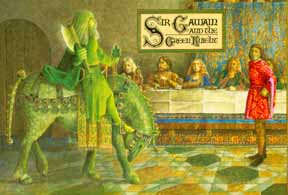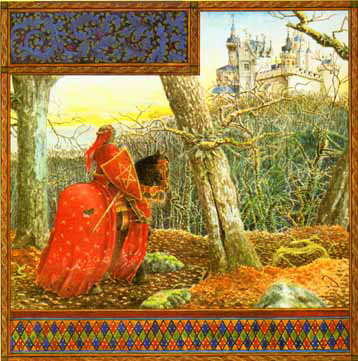Analysis of Sir Gawain and the Green Knight.
In Sir Gawain and the Green Knight, after Gawain ventures “into a forest fastness, fearsome and wild” (Norton, 311), he prays that he will be able to find “harborage” on Christmas Eve (Norton, 312).
It is the middle of winter, and Gawain has been traveling in search of the Green Knight whose head he has cut off.
After he prays and signs himself three times, Gawain finds a magical castle in the midst of a winter forest.
He rides to the castle and is granted permission to enter by the lord.
Gawain is attended to in a fashion befitting kings, and he meets the lord who tells his identity to all in the court.
There are many significant implications and foreshadowings which occur during Gawain’s stay at the castle.
Many references to the pentangle and Jesus Christ are found in this passage of Sir Gawain and the Green Knight.
The castle which appears after Sir Gawain prays has many odd characteristics, and its inhabitants seem to know who Gawain is before he tells them.
They seem to be waiting for the arrival of the young Gawain, who is venturing in search of the Green Knight.
Gawain is a dynamic, evolving character. As the story progresses, he matures and gains experience from his journey.
It is evident that Gawain is a loyal, religious, and honorable knight.
He is naďve and young, but he has the makings of an ideal knight.
Gawain shows honor and courage by honoring the agreement he makes with the Green Knight.
He ventures from Arthur’s court in search of the Green Knight and arrives in a forest where he prays for a place to stay so that he can hear mass on Christmas Eve: “No sooner had Sir Gawain signed himself thrice than he was ware, in the wood, of a wondrous dwelling” (Norton, 312).
Gawain sees a castle in the middle of a forest.
The castle magically appears after he prays to the Virgin Mary and the saints.
The castle grounds are an unusual contrast to the surrounding winter landscape, and this is the first of many unusual characteristics that the mysterious castle has.
The castle grounds are described as: “fair and green, in a goodly park with a palisade of palings planted about for two miles and more, round many a fair tree” (Norton, 312).
The description of a castle surrounded by lush fauna in the middle of winter is anything but normal.
Sir Gawain rides to the great castle and is quickly greeted by a porter.
He asks the porter to tell the lord he seeks harbor, and he is soon granted permission to enter the castle.
Gawain is royally greeted by the castle’s inhabitants; however, the treatment he receives from the attendants and knights is most unusual because no one knows who Sir Gawain is (or at least they shouldn’t; however, they seem to know that Gawain is a great knight).
The lord of the castle soon comes to greet Gawain.
Gawain is then taken to a luxurious room where he is undressed, given new clothing, and eats a magnificent dinner while warming by a fire. The following day Gawain identifies himself to the lord and his court.
The people laugh and are in high spirits. They seem as if they already know who Gawain is, and know the purpose of his visit.
The castle’s inhabitants describe Gawain as “the father of fine manners” (Norton, 315), and he seems to be highly regarded by all of the people of this strange stronghold.
The castle serves as a place for Gawain to undergo a series of trials (three to be exact).
Gawain will experience failure, but through his experiences, he will mature. Gawain’s failure proves that he is not perfect although he is often described in the poem as being so.
The pentangle on Gawain’s shield can be seen as a representation of perfection.
Gawain is explicitly described as one of God’s perfect creations in line 869: “So comely a mortal never Christ made as he” (Norton, 314).
Gawain is often linked to Christ, King Solomon, and the pentangle (which can signify the five wounds of the lord, truth, and perfection).
The fact that Gawain arrives at this magical place on Christmas Eve is very significant, and the temptation of Gawain is very similar to the biblical temptations of Adam in Eden, and Jesus in the desert.
The failure of Gawain shows he, as every mortal, is not perfect like the Christ.
His failure identifies him with ordinary people and pushes him to maturity.
The castle is an oasis in the middle of a dead forest which could be interpreted as being an Eden.
Though Gawain fails the last trial in the castle by not giving the lord a green girdle (he believes this will help him in his upcoming encounter with the mighty Green Knight), he still becomes the most mature knight of Arthur’s court.
Gawain eventually leaves the court as a more noble and experienced knight.
Gawain’s search for the Green Knight keeps him in the castle because the lord knows the location of the Green Chapel. However, everyone seems to know that Gawain is in search of the Chapel so that he may honor his agreement with the Green Knight:
Of all knights on earth most honored is he. Each
said solemnly aside to his brother, ‘Now displays of
deportment shall dazzle our eyes and the polished
pearls of impeccable speech; The high art of eloquence
is ours to pursue since the father of fine manners is
found in our midst (Norton, 315).
These lines show that the people of the castle have heard of Gawain before he arrives at the court. They speak of things before Gawain mentions anything about his knowledge of the green knight.
The people are planning to be dazzled by displays of deportment, and this is strange because these people should not know anything about Gawain.
The castle in which Sir Gawain seeks refuge for the Christmas season is full of mysterious implications and references. Many of the occurrences in the castle seem out of the ordinary, but Gawain’s arrival in the castle is essential to his growth as a person and knight.
Click here for an Audio Excerpt.
Back to Top
Music Playing: The One Who is Torn Apart by Nobuo Uematsu


Gawain is a dynamic, evolving character. As the story progresses, he matures and gains experience from his journey. It is evident that Gawain is a loyal, religious, and honorable knight. He is naďve and young, but he has the makings of an ideal knight. Gawain shows honor and courage by honoring the agreement he makes with the Green Knight. He ventures from Arthur’s court in search of the Green Knight and arrives in a forest where he prays for a place to stay so that he can hear mass on Christmas Eve: “No sooner had Sir Gawain signed himself thrice than he was ware, in the wood, of a wondrous dwelling” (Norton, 312). Gawain sees a castle in the middle of a forest. The castle magically appears after he prays to the Virgin Mary and the saints.
The castle grounds are an unusual contrast to the surrounding winter landscape, and this is the first of many unusual characteristics that the mysterious castle has. The castle grounds are described as: “fair and green, in a goodly park with a palisade of palings planted about for two miles and more, round many a fair tree” (Norton, 312). The description of a castle surrounded by lush fauna in the middle of winter is anything but normal. Sir Gawain rides to the great castle and is quickly greeted by a porter. He asks the porter to tell the lord he seeks harbor, and he is soon granted permission to enter the castle. Gawain is royally greeted by the castle’s inhabitants; however, the treatment he receives from the attendants and knights is most unusual because no one knows who Sir Gawain is (or at least they shouldn’t; however, they seem to know that Gawain is a great knight). The lord of the castle soon comes to greet Gawain. Gawain is then taken to a luxurious room where he is undressed, given new clothing, and eats a magnificent dinner while warming by a fire. The following day Gawain identifies himself to the lord and his court. The people laugh and are in high spirits. They seem as if they already know who Gawain is, and know the purpose of his visit. The castle’s inhabitants describe Gawain as “the father of fine manners” (Norton, 315), and he seems to be highly regarded by all of the people of this strange stronghold.
The castle serves as a place for Gawain to undergo a series of trials (three to be exact). Gawain will experience failure, but through his experiences, he will mature. Gawain’s failure proves that he is not perfect although he is often described in the poem as being so. The pentangle on Gawain’s shield can be seen as a representation of perfection. Gawain is explicitly described as one of God’s perfect creations in line 869: “So comely a mortal never Christ made as he” (Norton, 314).
Gawain is often linked to Christ, King Solomon, and the pentangle (which can signify the five wounds of the lord, truth, and perfection). The fact that Gawain arrives at this magical place on Christmas Eve is very significant, and the temptation of Gawain is very similar to the biblical temptations of Adam in Eden, and Jesus in the desert. The failure of Gawain shows he, as every mortal, is not perfect like the Christ. His failure identifies him with ordinary people and pushes him to maturity. The castle is an oasis in the middle of a dead forest which could be interpreted as being an Eden. Though Gawain fails the last trial in the castle by not giving the lord a green girdle (he believes this will help him in his upcoming encounter with the mighty Green Knight), he still becomes the most mature knight of Arthur’s court. Gawain eventually leaves the court as a more noble and experienced knight.
Gawain’s search for the Green Knight keeps him in the castle because the lord knows the location of the Green Chapel. However, everyone seems to know that Gawain is in search of the Chapel so that he may honor his agreement with the Green Knight:
Of all knights on earth most honored is he. Each said solemnly aside to his brother, ‘Now displays of deportment shall dazzle our eyes and the polished pearls of impeccable speech; The high art of eloquence is ours to pursue since the father of fine manners is found in our midst (Norton, 315).
These lines show that the people of the castle have heard of Gawain before he arrives at the court. They speak of things before Gawain mentions anything about his knowledge of the green knight. The people are planning to be dazzled by displays of deportment, and this is strange because these people should not know anything about Gawain.
The castle in which Sir Gawain seeks refuge for the Christmas season is full of mysterious implications and references. Many of the occurrences in the castle seem out of the ordinary, but Gawain’s arrival in the castle is essential to his growth as a person and knight.
Click here for an Audio Excerpt.
Back to Top
Music Playing: The One Who is Torn Apart by Nobuo Uematsu


